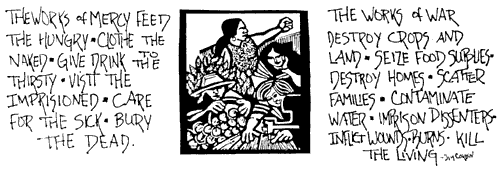The fall is beginning, and the nights here are beginning to get the moist chill so familiar to a Northwest boy like myself. I can’t wait to see my breath in the air in the morning.
I went to visit the Guadalupe House Catholic Worker in
There is a beautiful view from
There is a mural painted on a retaining wall that runs along the west side of the street, with bright, bold colors, blue and orange, red and green. A weathered hand holds up a squash, a hammer breaks the chain binding down a fist. A vegetable garden, about a half acre in sized, occupies the opposite side of the street. And Guadalupe just beyond.
As we approached the house an old Hispanic man greeted us from the porch. His face was like crumpled burlap; deep wrinkles running south from his cheekbones parted around his mouth and his skin puffed out around his eyes. He flashed a friendly but wily smile at us, like he knew something we didn’t. We introduced ourselves and he showed us inside.
I was very excited to meet Father Bix. I had heard so much about him, a priest, an old wobbly, and a catholic worker. I imagined him to be a big, burly man with a gruff voice, but comfortable in his collar as he is in the struggle against injustice. And Spartacus was said to be seven feet tall, right? I blushed a little to myself as I noticed my tendency to build up heroes in my own mind.
The interior walls of Guadalupe House are cluttered with icons, crucifix’s, and prayers written on scraps of paper and pasted up, so that one is filled with the sense of being in some kind of church or holy place, except that each piece was placed by a different person at a different time with no overall scheme but the organic rhythms of people living in community.
A fellow sitting in the corner hollered at me, “Hey Abraham!” as we walked into the dining room. I found this funny because no-one else would think me an Abraham type, and he looked quite a bit like a Moses, with shoulder length matted grey hair and a beard of equal length with no part or seam to distinguish beard from hair. I smiled and said, “Hi, my name is Phil”, and we shook hands. A middle aged woman named Dotti, one of the workers, greeted us warmly and then went to tend to the concerns of one of the guests. Megan and I stood around awkwardly for a minute, shifting on our feet and looking around, and then we each found a seat on the couches lining the north wall.
A man, roughly my age, was seated next to me, and I found upon inquiring that he had just completed a year in the Jesuit Volunteer Corps, and had been temporarily hired on as paid staff at his old placement at the Nativity House. He informed me that the Tacoma Catholic Worker community consisted of five houses within a two block radius, and 25 live-in volunteers. These houses included the Guadalupe House of Hospitality as well as a house of prayer. Guadalupe serves dinner on Monday, Tuesday, and Wednesday nights, with the Tuesday dinner being preceded by liturgy. The staff take turns leading the liturgy. In the mornings showers and laundry are offered, as well as the customary pot of coffee. There are about 15 guests living in the five bedrooms of the house, and I’m not sure where the staff sleep. They have a strong relationship with the local parish, as well as with the Nativity House (which is, I believe, a project of Catholic Community Services).
Dotti called us to gather close for the liturgy, and began with a prayer. We sang a psalm, and then the readings: a story from the Book of Ezra about the rebuilding of the temple and the return of the Jews from exile, and a reading from the Gospel in which Jesus denies his family and says that all who listen to the word of the Lord are his family.
A discussion followed, and a man across the room spoke up. “God talks to me all the time,” he said. “It’s simple. There are two paths. The good one and the bad one. God tells me, ‘Get sober’. But I take the low road, I still use. I just got out of jail, and I know I’m a goin’ back. I talked with my kids on the phone the other day, but I ain’t seen ‘em in fifteen years…” His voice broke, and his eyes welled up.
At the end of the service, we lined up to eat, and another dozen hungry people who had opted out of participating in the liturgy crowded into the room for the meal. The food was fantastic. There was chicken and rice, a variety of salads, pasta, and corn bread with peanuts and bacon cooked in.
After the meal, Megan and I both moved into the kitchen to help clean up. A fellow named Chuck was directing the cleanup. He was one of those “God’s children” types, the kind you feel good just being around. He loved to talk, to ramble on-and-on, and kind of danced around as he talked and cleaned. He had a cleft palate, a speech impediment, and, I think, a mild blend of mental illness with developmental disability. But he could, and loved to, run a kitchen crew, and we all gladly obeyed his directions. I was reminded of the “old” Bread & Roses.



No comments:
Post a Comment